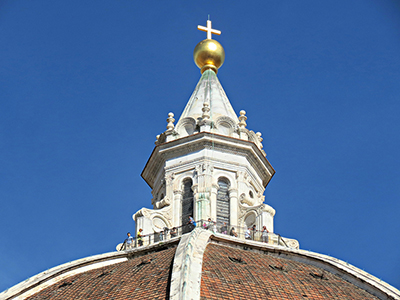Standing out as one of the most momentous undertaking of the Renaissance, the Florence Cathedral Lantern by Filippo Brunelleschi was a most imposing task that had Florentines lodged in debates and oppositions for years.
Once completed, thanks to the brilliance of the renowned architect, became the icon of the city and a hallmark in Renaissance architecture revolution. Originally an openwork construction made of timber placed on top of a building, a Lantern in Architecture during the Florence Renaissance era came to mean a small cupola-like structure, usually embellished with decorative arcades and mounted on top of a dome. Although many a time designed to serve purpose in admitting light to the interior, it is essentially a proportional element in the visual design. Renaissance revolution in Florence is inextricably linked with the construction of the dome of its new cathedral, a pivotal project that was particularly inspirational in Early Renaissance art and did much to confirm Florentine prominence during the Quattrocento Rinascimento era.
Arnolfo di Cambio's design and construction for the Cathedral of Florence, which became even more striking thanks to Francesco Talenti’s amendments, had left the basilica (the Cathedral of Saint Mary of the Flower) with a colossal distress that is securing the chancel with a roofing. Although Arnolfo’s conception undoubtedly included a cupola, the cathedral was in the end, so enormous that usual methods of scaffolding from the ground level could not be utilized. The technical means by which to construct the dome had not yet been established, nonetheless, it looked like quite the impossible task to roof a space of 46 Meters in breadth without some sort of fortification.
The inconceivable challenge was however solved by Filippo Brunelleschi, a skilled practitioner in the rules of mathematics and perspective, as well as an avid enthusiast for construction techniques used by ancient Romans. Brunelleschi got his final inspiration for the project from the adept study pantheon’s cupola which had likewise been constructed with a double wall and without scaffolding. After returning to Florence Brunelleschi submitted that a drum be constructed above the chancel and soon after the erection of this structure was completed, he headed back to Rome, chased by frantic communications from the council overseen the construction of the dome. In time, Brunelleschi recommended pronouncing a competition for the cupola project but with the following key provisions: the cupola had to take an octagonal in shape, be of 46 metres in diameter at its base, constructed without scaffolding and at the slightest double in size. A competition of which he was quite sure he would win.
In 1418, the competition for the construction of the Florence Cathedral Lantern was held, and Brunelleschi emerged victorious. However, the directors had but one more stipulation that Lorenzo Ghiberti should collaborate with him as an overseer for the work. Distraught and frustrated, Brunelleschi was so irritated that he nearly wrecked his model. It was his friends Luca Della Robbia and Donatello that in place advised him to fake he was ill and turn in all responsibility and obligations to Ghiberti. Having followed their guidance, it wasn't too long until Ghiberti came to a cessation and disclosed that he was unable to grasp the full workings and implementation of the project.
Having emerged victorious over his rival, Brunelleschi commenced the erection of the lantern in 1420 and immersed the rest of his lifetime working on the project, even though he did still oversee the construction of other monuments that were vital to the legacy of Renaissance Florence. The last tribute that he erected consisted of a 91 metres high double cupola of brick, wholly self-supporting and grounded on a profound system of flying instead of using fixed centre rings. The peripheral of the cupola spotted stone ribs and domical vaults, but all together reproducing the same pointy arch profile desired to utter precision.
In 1434, the Prodigious Cupola or the "Cupolone", as the locals often christened it ever since erection, was finalized. Two years down the line, the lantern was in turn locked in position, taking the momentous construction from 91 to 114.5 Metres. While in 1438, the tribunes occupying recesses formed in the construction of the octagon lantern apse were built. The adornments in the lantern, on the other hand, were concluded by 1446, when Brunelleschi was on his deathbed. In 1461, finishing touches to the lantern’s decorations were done, with the placing of the remarkable copper sphere being done by 1474. Cast in Verrocchio’s workshop and pulleyed up through a machine constructed with aid of Leonardo da Vinci. However, on July 17th 1600, the bell fell on the account of being hit by lightning and was interchanged two years down the line with an even bigger one. A marble plaque honouring this occurrence is still discernable on the paving behind the cathedral.
Worth noting is that the embellishment of the galleria across the drum section was never finalized. The balustrade made by Baccio d’Agnolo and applied to just one side of the drum’s interior did not meet the accord of Michelangelo who defined it as a cage for crickets, outright decreeing its condemnation. Brunelleschi’s model was however later on replicated by Michelangelo di Lodovico Buonarroti Simoni for the cupola of St. Peter's in Rome. All in all, although is it somewhat tiring to climb up Brunelleschi’s cathedral lantern, it is extremely profound for it provides understanding as to the method the architect applied to construct it, while also giving forth a magnificent view over the city. Moreover, it is promising and satisfying to take a break in the dome while climbing up, giving you a better view of the murals such as the Last Judgement by Federico Zucchari and Giorgio Vasari.




